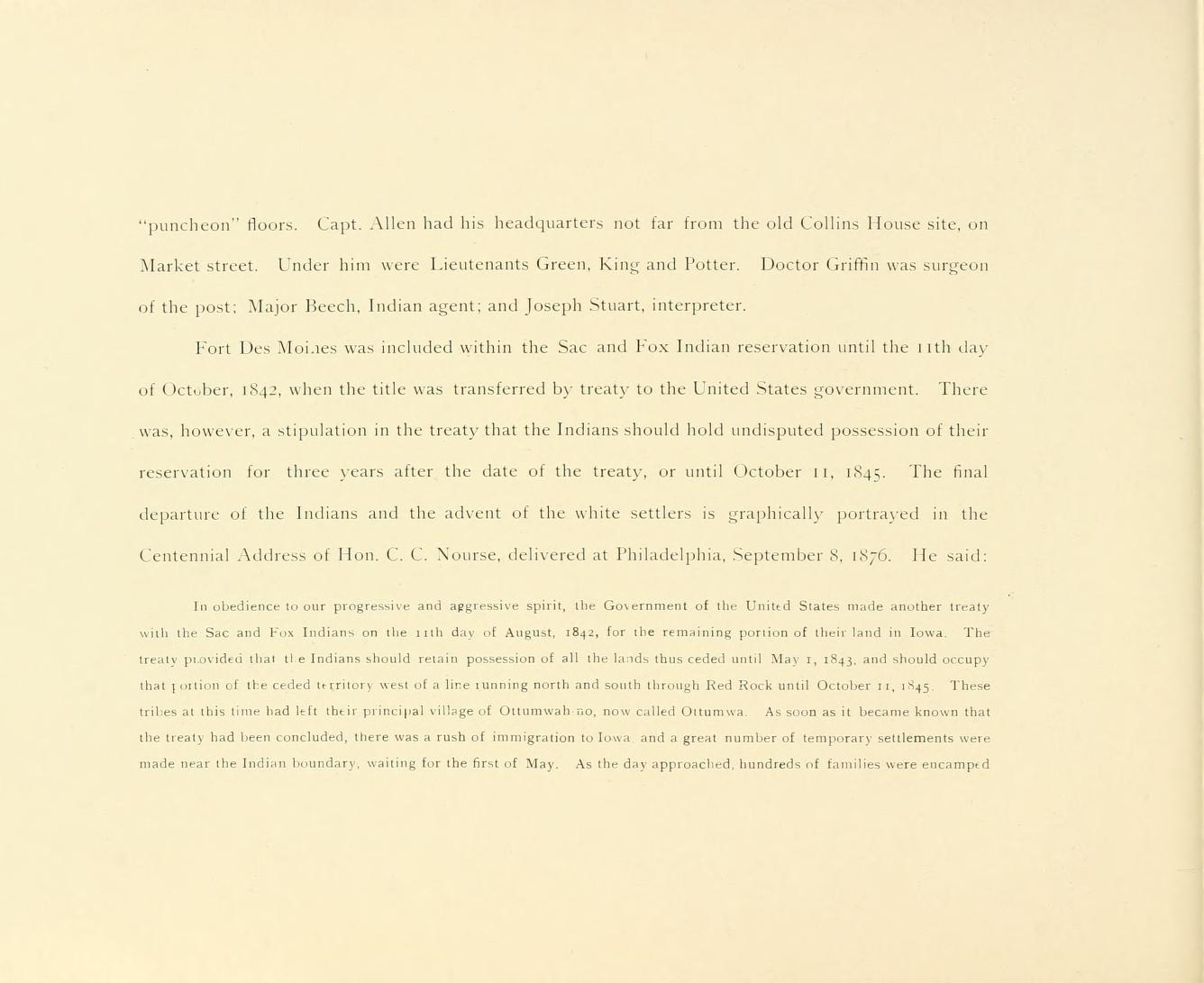DES MOINES
Illustrated Souvenir Album (1895)
EARLY HISTORY OF DES MOINES.
Like many western cities, the origin and foundation of the city of Des Moines was a fort, erected by the government in an Indian country. This fort was built in 1843 by Capt. James Allen, and was called Fort Des Moines from its situation on the Des Moines river. The name was also for some time attached to the straggling frontier village, which gradually grew up around the garrison. The expedition for the erection of the fort came up the Des Moines river from Fort Sanford and arrived on the 9th of May, 1843, with a small detachment of United States troops on board the steamer IONE. This was the first steamer that ever ascended the Des Moines as far north as the present capital of Iowa. Effecting a landing at what is now the foot of Court Avenue, the troops and military stores were disembarked and Capt. Allen returned with the steamer to Fort Sanford to bring the rest of the soldiers and supplies. The full garrison, when they arrived, consisted of one hundred and twenty-five officers and men. The erection of the fort was at once commenced, which soon reared its log palisades near the mouth of the Raccoon, at its confluence with the Des Moines. The barracks were built of rough logs, one story high, with stone chimneys and "puncheon" floors. Capt. Allen had his headquarters not far from the old Collins House site, on Market street. Under him were Lieutenants Green, King and Potter. Doctor Griffin was surgeon of the post: Major Beech, Indian agent; and Joseph Stuart, interpreter.
Fort Des Moines was included within the Sac and Fox Indian reservation until the 11th day of October, 1842, when the title was transferred by treaty to the United States government. There was, however, a stipulation in the treaty that the Indians should hold undisputed possession of their reservation for three years after the date of the treaty, or until October 11, 1845. The final departure of the Indians and the advent of the white settlers is graphically portrayed in the Centennial Address of Hon. C. C. Nourse, delivered at Philadelphia, September 8, 1876. He said:
In obedience to our progressive and aggressive spirit, the Government of the United States made another treaty with the Sac and Fox Indians on the 11th day of August, 1842, for the remaining portion of their land in Iowa. The treaty provided that the Indians should retain possession of all the lands thus ceded until May 1, 1843, and should occupy that portion of the ceded territory west of a line running north and south through Red Rock until October 11, 1845. These tribes at this time had left their principal village of Ottumwah-no, now called Ottumwa. As soon as it became known that the treaty had been concluded, there was a rush of immigration to Iowa and a great number of temporary settlements were made near the Indian boundary, waiting for the first of May. As the day approached, hundreds of families were encamped along the line, and their tents and wagons gave the scene the appearance of a military expedition. The country beyond had been thoroughly explored, but the United States military authorities had prevented any settlements, or even the marking out of claims by any monuments whatever. To aid them in marking out their claims, when the hour should arrive, the settlers had placed piles of dry wood on the rising ground at convenient distances, and a short time before 12 o'clock of the night of the 30th of April, these were lighted, and when the midnight hour arrived it was announced by the discharge of firearms. The night was dark, but this army of occupation pressed forward, torch in hand, with axe and hatchet blazing lines with all manner of corners and angles. When daylight came and revealed the confusion of these wonderful surveys, numerous disputes arose, settled generally by compromise, but sometimes by violence. Between midnight of the 30th of April and sundown o f the first of May, over one thousand families had settled in this new purchase. While this scene was transpiring the retreating Indian was enacting one more impressive and melancholy. The winter of 1842-43 was one of unusual severity, and the Indian prophet, who had disapproved of the treaty, attributed the severity of the winter to the anger of the Great Spirit because they had sold their country. Many religious rites were performed to atone for the crime. When the time for leaving Ottumwah-no arrived, a solemn silence pervaded the camp, and the faces of their stoutest men were bathed in tears; and when their cavalcade was put in motion toward the setting sun, there was a spontaneous outburst of frantic grief from the entire procession. The Indians remained the appointed time beyond the line running north and south through Red Rock. The government established a trading post and military encampment at the Raccoon Fork of the Des Moines river, then and for many years known as Fort Des Moines. Here the red man lingered until the 11th of October, 1845, when the same scene that was before described was re-enacted, and the wave of immigration swept over the remainder of the "New Purchase."
Fort Des Moines was included within the Sac and Fox Indian reservation until the 11th day of October, 1842, when the title was transferred by treaty to the United States government. There was, however, a stipulation in the treaty that the Indians should hold undisputed possession of their reservation for three years after the date of the treaty, or until October 11, 1845. The final departure of the Indians and the advent of the white settlers is graphically portrayed in the Centennial Address of Hon. C. C. Nourse, delivered at Philadelphia, September 8, 1876. He said:
In obedience to our progressive and aggressive spirit, the Government of the United States made another treaty with the Sac and Fox Indians on the 11th day of August, 1842, for the remaining portion of their land in Iowa. The treaty provided that the Indians should retain possession of all the lands thus ceded until May 1, 1843, and should occupy that portion of the ceded territory west of a line running north and south through Red Rock until October 11, 1845. These tribes at this time had left their principal village of Ottumwah-no, now called Ottumwa. As soon as it became known that the treaty had been concluded, there was a rush of immigration to Iowa and a great number of temporary settlements were made near the Indian boundary, waiting for the first of May. As the day approached, hundreds of families were encamped along the line, and their tents and wagons gave the scene the appearance of a military expedition. The country beyond had been thoroughly explored, but the United States military authorities had prevented any settlements, or even the marking out of claims by any monuments whatever. To aid them in marking out their claims, when the hour should arrive, the settlers had placed piles of dry wood on the rising ground at convenient distances, and a short time before 12 o'clock of the night of the 30th of April, these were lighted, and when the midnight hour arrived it was announced by the discharge of firearms. The night was dark, but this army of occupation pressed forward, torch in hand, with axe and hatchet blazing lines with all manner of corners and angles. When daylight came and revealed the confusion of these wonderful surveys, numerous disputes arose, settled generally by compromise, but sometimes by violence. Between midnight of the 30th of April and sundown o f the first of May, over one thousand families had settled in this new purchase. While this scene was transpiring the retreating Indian was enacting one more impressive and melancholy. The winter of 1842-43 was one of unusual severity, and the Indian prophet, who had disapproved of the treaty, attributed the severity of the winter to the anger of the Great Spirit because they had sold their country. Many religious rites were performed to atone for the crime. When the time for leaving Ottumwah-no arrived, a solemn silence pervaded the camp, and the faces of their stoutest men were bathed in tears; and when their cavalcade was put in motion toward the setting sun, there was a spontaneous outburst of frantic grief from the entire procession. The Indians remained the appointed time beyond the line running north and south through Red Rock. The government established a trading post and military encampment at the Raccoon Fork of the Des Moines river, then and for many years known as Fort Des Moines. Here the red man lingered until the 11th of October, 1845, when the same scene that was before described was re-enacted, and the wave of immigration swept over the remainder of the "New Purchase."



| GEORGE B. FLEMING, | JOHN R. SAGE, | Dr. GEORGE M. CHAPPELL, |
|---|---|---|
| Special Examiner U. S. Pension Bureau. | Iowa Weather and Crop Service. | U. S. Weather Bureau. |
| WILLIAM H. PENN, | MORITZ STERN, | CHARLES H. ROBINSON, |
| Chief of U. S. Railway Mail Service. | Department U. S. Revenue Collection. | U. S. Pension Agent. |

POLK COUNTY COURT HOUSE.
Prev < == Index == > Next
Copyright © 1996
The IAGenWeb Project
IAGenWeb Terms, Conditions & Disclaimer

